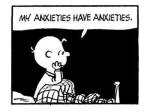
A little earlier today, I experienced a moment – really, it was no longer than a minute – during which I thought of about 15 things that I need to do sooner rather than later. That unbidden to-do list was followed by a wave of despair: “How would I ever get all of it done? I just can handle it all. Maybe I should just quit.”
And just like a snap of the fingers, it was gone. But the damage was done. I was feeling panicked – it felt like my neck was on fire, I was nauseated, and the seat felt unsteady below me. The specific symptoms we experience when anxious or panicky may vary but most of us are familiar with that underlying dread that our situation is hopeless.
The rest of my day – during which I had intended to get a lot done, like finishing grading papers and making more progress on my tax returns – was imperiled. I had thought about quitting. Quitting what, exactly? My job, paying taxes, living? Thinking about that made me laugh a little too loudly for someone sitting at a corner table at Starbucks.
So, what did I do? I focused first and foremost on getting my breathing under control. At this point, the entire episode had lasted just a few minutes, but I was close to hyperventilating the whole time. I closed my eyes, rested my hands in my lap and unclenched them, and slowed my breathing bit by bit. Inhaling more slowly and deeply, exhaling more slowly and completely. Repeat. Repeat. Repeat. Until it felt natural.
That freak-out of a to-do list was waiting for me but I had the benefit of some semblance of calm to consider it more rationally. It was a long list, to be certain, full of things that need to be done sooner rather than later. But not right this minute, not in this moment, not all of them, not even all of one of them.
Taking a mindful approach to life, living in each successive moment, we can observe a daunting task and recognize without judgment that it will take a while to accomplish, that we cannot bite it all off in one chew, and that that does not make us insufficient or incapable. The task is what it is, and we are what we are.
I personally find that a task performed mindfully finishes more quickly than expected. Or that the time spent did not seem as long. It doesn’t really matter which. The likely outcome is better than if it had been achieved with much angst and drama. Certainly, we feel better afterward, and in suitable condition to move onto the next task, if need be.
Of course, the other thing I did to cope with that moment of panic was to blog about it. (For better or worse, this post is the product. Hope it’s better.) Blogging is not necessary, but it’s important to pause and look at what we just experienced in those moments of anxiety. Our impulse is to move along as quickly as possible and leave the wreckage in the rearview mirror, but that doesn’t really benefit us in any way. It is insufficient to deal with the present moment’s disturbance, and doesn’t help us to cope with future incidents.
We should take a moment, once our breath has returned to normal, to think about what just happened and why. What triggered it? Why did that list scroll through my brain at that particular moment? I’m not certain, even after having taken the time to write this post. But I’m open to finding out, so I can move on for now without knowing the answer, because I feel like I can handle it when it arrives and I don’t need to dwell on it in the interim.
Thanks for hanging with my while I re-centered myself and reestablished balance and mindfulness.





